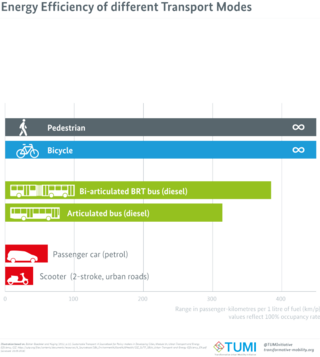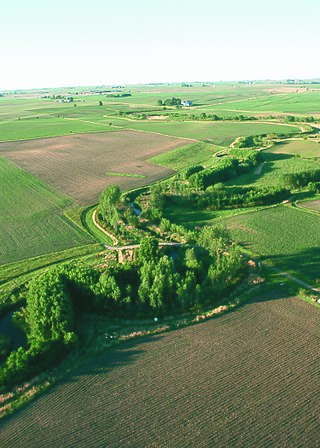
The United Nations Global Compact is a non-binding United Nations pact to get businesses and firms worldwide to adopt sustainable and socially responsible policies, and to report on their implementation. The organization solicits commitments to specific sustainability and social responsibility goals from CEOs and highest-level executives, and in turn offers training, peer-networks and a functional framework for responsibility.
Adaptive reuse refers to the process of reusing an existing building for a purpose other than which it was originally built or designed for. It is also known as recycling and conversion. Adaptive reuse is an effective strategy for optimizing the operational and commercial performance of built assets. Adaptive reuse of buildings can be an attractive alternative to new construction in terms of sustainability and a circular economy. It has prevented thousands of buildings' demolition and has allowed them to become critical components of urban regeneration. Not every old building can qualify for adaptive reuse. Architects, developers, builders and entrepreneurs who wish to become involved in rejuvenating and reconstructing a building must first make sure that the finished product will serve the need of the market, that it will be completely useful for its new purpose, and that it will be competitively priced.
The United Nations Human Settlements Programme (UN-Habitat) is the United Nations programme for human settlements and sustainable urban development. It was established in 1977 as an outcome of the first United Nations Conference on Human Settlements and Sustainable Urban Development held in Vancouver, Canada, in 1976. UN-Habitat maintains its headquarters at the United Nations Office at Nairobi, Kenya. It is mandated by the United Nations General Assembly to promote socially and environmentally sustainable towns and cities with the goal of providing adequate shelter for all. It is a member of the United Nations Development Group. The mandate of UN-Habitat derives from the Habitat Agenda, adopted by the United Nations Conference on Human Settlements in Istanbul, Turkey, in 1996. The twin goals of the Habitat Agenda are adequate shelter for all and the development of sustainable human settlements in an urbanizing world.

Environmental planning is the process of facilitating decision making to carry out land development with the consideration given to the natural environment, social, political, economic and governance factors and provides a holistic framework to achieve sustainable outcomes. A major goal of environmental planning is to create sustainable communities, which aim to conserve and protect undeveloped land.
The "Melbourne Principles" for Sustainable Cities are ten short statements on how cities can become more sustainable. They were developed in Melbourne (Australia) on 2 April 2002 during an international Charrette, sponsored by the United Nations Environment Programme (UNEP) and the International Council for Local Environmental Initiatives. Experts at the Charrette were drawn from developing and developed countries.

The sustainable city, eco-city, or green city is a city designed with consideration for social, economic, environmental impact, and resilient habitat for existing populations, without compromising the ability of future generations to experience the same. The UN Sustainable Development Goal 11 defines sustainable cities as those that are dedicated to achieving green sustainability, social sustainability and economic sustainability. They are committed to doing so by enabling opportunities for all through a design focused on inclusivity as well as maintaining a sustainable economic growth. The focus also includes minimizing required inputs of energy, water, and food, and drastically reducing waste, output of heat, air pollution – CO2, methane, and water pollution. Richard Register, a visual artist, first coined the term ecocity in his 1987 book Ecocity Berkeley: Building Cities for a Healthy Future, where he offers innovative city planning solutions that would work anywhere. Other leading figures who envisioned sustainable cities are architect Paul F Downton, who later founded the company Ecopolis Pty Ltd, as well as authors Timothy Beatley and Steffen Lehmann, who have written extensively on the subject. The field of industrial ecology is sometimes used in planning these cities.

Brian Leslie HoweAO is a retired Australian politician and Uniting Church minister. He served as Deputy Prime Minister of Australia and deputy leader of the Labor Party from 1991 to 1995, under Bob Hawke and Paul Keating. He was a government minister continuously from 1983 to 1996, and a member of the House of Representatives from 1977 to 1996, representing the Division of Batman in Victoria.

Solar Cities is an innovative A$97 million demonstration programme designed to promote solar power, smart meters, energy conservation and new approaches to electricity pricing to provide a sustainable energy future in urban locations throughout Australia. Adelaide, Alice Springs, Blacktown, Central Victoria and Townsville were nominated to be the first Solar Cities of Australia, in the 2007 election campaign the Labor government committed to expanding the programme to include Coburg and Perth. Solar Cities is an innovative program that aims to show how technology, behavior change, and new approaches to energy pricing can combine to provide a sustainable energy future in urban locations throughout Australia".

Public housing in Australia is provided by departments of state governments. Australian public housing operates within the framework of the Commonwealth-State Housing Agreement, by which funding for public housing is provided by both federal and state governments. According to the 2006 census, Australia's public housing stock consisted of some 304,000 dwellings out of a total housing stock of more than 7.1 million dwellings, or 4.2% of all housing stock.
The Building and Construction Improvement Program(BACIP) is a program of the Aga Khan Planning and Building Service, Pakistan (AKPBS,P) that is engaged in developing and promoting solutions to housing and built environment-related issues of rural communities living in Gilgit-Baltistan and the province of Sindh.
The Holcim Foundation for Sustainable Construction is a non-profit organization. Its goal is to raise awareness of the role that architecture, engineering, urban planning and construction have in achieving a sustainable built future. The organization encourages and rewards sustainable responses to the technological, environmental, socioeconomic, and cultural issues affecting building and construction. The Holcim Foundation for Sustainable Construction promotes thought leadership on a greener, smarter, circular, and more inclusive built environment.
Homeshare is the exchange of housing for help in the home. A householder, typically an aged person with a spare room, offers free or low-cost accommodation to another person in exchange for an agreed level of support. The support may include companionship, shopping, household tasks, gardening, care of pets and, increasingly, help to use the computer. Homeshare thus provides a solution to the needs of two groups of people - those in need of affordable housing, often younger people, and those in need of some support to live at home, usually older people. Homeshare programmes, many run by voluntary bodies, have taken root in at least thirteen countries worldwide, some of them with public funding.

Water-sensitive urban design (WSUD) is a land planning and engineering design approach which integrates the urban water cycle, including stormwater, groundwater, and wastewater management and water supply, into urban design to minimise environmental degradation and improve aesthetic and recreational appeal. WSUD is a term used in the Middle East and Australia and is similar to low-impact development (LID), a term used in the United States; and Sustainable Drainage System (SuDS), a term used in the United Kingdom.

Sustainable urbanism is both the study of cities and the practices to build them (urbanism), that focuses on promoting their long term viability by reducing consumption, waste and harmful impacts on people and place while enhancing the overall well-being of both people and place. Well-being includes the physical, ecological, economic, social, health and equity factors, among others, that comprise cities and their populations. In the context of contemporary urbanism, the term cities refers to several scales of human settlements from towns to cities, metropolises and mega-city regions that includes their peripheries / suburbs / exurbs. Sustainability is a key component to professional practice in urban planning and urban design along with its related disciplines landscape architecture, architecture, and civil and environmental engineering. Green urbanism and ecological urbanism are other common terms that are similar to sustainable urbanism, however they can be construed as focusing more on the natural environment and ecosystems and less on economic and social aspects. Also related to sustainable urbanism are the practices of land development called Sustainable development, which is the process of physically constructing sustainable buildings, as well as the practices of urban planning called smart growth or growth management, which denote the processes of planning, designing, and building urban settlements that are more sustainable than if they were not planned according to sustainability criteria and principles.

Circles of Sustainability is a method for understanding and assessing sustainability, and for project management directed towards socially sustainable outcomes. It is intended to handle 'seemingly intractable problems' such as outlined in sustainable development debates. The method is mostly used for cities and urban settlements.
Wintringham, based in Victoria, Australia, is a secular, not-for-profit welfare company providing advocacy, support and aged care services to elderly homeless men and women, and to financially disadvantaged elderly people who are at risk of homelessness.

Nature-based solutions (NBS) is the sustainable management and use of natural features and processes to tackle socio-environmental issues. These issues include climate change, water security, water pollution, food security, human health, biodiversity loss, and disaster risk management. The European Commission's definition of NBS states that these solutions are "inspired and supported by nature, which are cost-effective, simultaneously provide environmental, social and economic benefits and help build resilience. Such solutions bring more, and more diverse, nature and natural features and processes into cities, landscapes, and seascapes, through locally adapted, resource-efficient and systemic interventions". In 2020, the EC definition was updated to further emphasise that “Nature-based solutions must benefit biodiversity and support the delivery of a range of ecosystem services.” Through the use of NBS healthy, resilient, and diverse ecosystems can provide solutions for the benefit of both societies and overall biodiversity.
Precise definitions of sustainable construction vary from place to place, and are constantly evolving to encompass varying approaches and priorities. In the United States, the Environmental Protection Agency (EPA) defines sustainable construction as "the practice of creating structures and using processes that are environmentally responsible and resource-efficient throughout a building's life-cycle from siting to design, construction, operation, maintenance, renovation and deconstruction." The Netherlands defines sustainable construction as "a way of building which aims at reducing (negative) health and environmental impacts caused by the construction process or by buildings or by the built-up environment." More comprehensively, sustainability can be considered from three dimension of planet, people and profit across the entire construction supply chain. Key concepts include the protection of the natural environment, choice of non-toxic materials, reduction and reuse of resources, waste minimization, and the use of life-cycle cost analysis.

Sarah Bekessy is an Australian interdisciplinary conservation scientist with a background in conservation biology and experience in social sciences, planning, and design. Her research interests focus on the intersection between science, policy, and the design of environmental management. She is currently a professor and ARC Future Fellow at RMIT University in the School of Global, Urban and Social Studies. She leads the Interdisciplinary Conservation Science Research Group.

Joe Flood is a policy, data analyst and mathematician. He has made contributions to mathematics, housing and urban economics, urban indicators, slum studies, climate change and genetic genealogy at every layer of Australian government.











